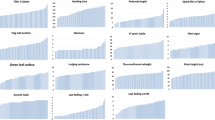Abstract
A mutant population of spring wheat cv. Cadenza was produced at Rothamsted Research in 2004–5, both for TILLING and to generate variation in the contents of phytochemical components studied in the Healthgrain program. The agronomic and morphological properties of this mutant hexaploid wheat population (generations M3–M6) were studied in a 3-year field experiment. Most of the traits were scored according to UPOV TG/3/11, namely the time of ear emergence, plant height, ear glaucosity, shape, density and length, presence of awns and scurs, seasonal type, and grain colour. Other characters such as visible mutant phenotypes, ear sterility, heterogeneity of head rows, leaf colour and responses to powdery mildew and leaf rust were also studied. Variation in certain breadmaking quality parameters was also studied. The EMS mutant Cadenza lines studied showed wide diversity in terms of morphological and agronomic properties. The variation in agronomic properties was lower in 2007 and 2008 than in 2006, partly because of the SSD (single seed descent) in the M4 generation and partly because of the loss of late heading genotypes. The diversity was lowest in 2007, probably due to the extremely dry weather.




Similar content being viewed by others
References
AACC Method 55-31 (1999a) Physical tests. Singel-kernel characterization system for wheat kernel texture. AACC International, St. Paul, USA
AACC Method 76-13 (1999b) Total starch assay procedure. Megazyme amyloglucosidase/α-amylase method. AACC International, St. Paul, USA
Caldwell DG, McCallum N, Shaw P, Muehlbauer GJ, Marshall DF, Waugh R (2004) A structured mutant population for forward and reverse genetics in barley (Hordeum vulgare L.). Plant J 40:143–150
ICC 105/2 (1995a) Determination of crude protein in cereals and cereal products for food and for feed. International Association for Cereal Science and Technology, Vienna
ICC 115/1 (1995b) Method for using Brabender farinograph. International Association for Cereal Science and Technology, Vienna
ICC 116/1 (1995c) Determination of the sedimentation value (according to Zeleny) as an approximate measure of baking quality. International Association for Cereal Science and Technology, Vienna
ICC 137/1 (1995d) Mechanical determination of the wet gluten content of wheat flour (Glutomatic). International Association for Cereal Science and Technology, Vienna
ICC 155 (1995e) Determination of wet gluten quantity and quality (gluten index ac. to Perten) of whole wheat meal and wheat flour (Triticum aestivum). International Association for Cereal Science and Technology, Vienna
McCallum CM, Comai L, Greene EA, Henikoff S (2000) Targeting induced local lesions in genomes (TILLING) for plant functional genomics. Plant Physiol 123:439–442
Parry MAJ, Madgwick PJ, Bayon C, Tearall K et al (2009) Mutation discovery for crop improvement. J Exp Bot 60:2817–2825
Poutanen K, Shepherd R, Shewry PR, Delcour JA et al (2008) Beyond whole grain: the European HEALTHGRAIN project aims at healthier cereal foods. Cereal Food World 53:32–35
Slade AJ, Fuerstenberg SI, Loeffler D, Steine MN, Facciotti D (2005) A reverse genetic, nontransgenic approach to wheat crop improvement by TILLING. Nat Biotechnol 23:75–81
Sourdille P, Cadalen T, Gay G, Gill B, Bernard M (2002) Molecular and physical mapping of genes affecting awning in wheat. Plant Breed 121:320–324
Suzuki T, Eiguchi M, Kumamaru T, Satoh H et al (2008) MNU-induced mutant pools and high performance TILLING enable finding of any gene mutation in rice. Mol Genet Genomics 279:213–223
Talame V, Bovina R, Sanguineti MC, Tuberosa R et al (2008) TILLMore, a resource for the discovery of chemically induced mutants in barley. Plant Biotechnol J 6:477–485
Ward J, Poutanen K, Gebruers K, Piironen V et al (2008) The HEALTHGRAIN cereal diversity screen: concept, results and prospects. J Agric Food Chem 56:9699–9709
Weil CF (2009) TILLING in grass species. Plant Physiol 149:158–164
Weil CF, Monde RA, Till BJ, Comai L, Henikoff S (2005) Mutagenesis and functional genomics in maize. Maydica 50:415–424
Wiley PR, Tosi P, Evrard A, Lovegrove A et al (2007) Promoter analysis and immunolocalisation show that puroindoline genes are exclusively expressed in starchy endosperm cells of wheat grain. Plant Mol Biol 64:125–136
Xin ZG, Wang ML, Barkley NA, Burow G et al (2008) Applying genotyping (TILLING) and phenotyping analyses to elucidate gene function in a chemically induced sorghum mutant population. BMC Plant Biol 8:103
Acknowledgments
This work was financially supported by the European Commission in the Communities 6th Framework programme, Project HEALTHGRAIN (FOOD-CT-2005-514008). It reflects the authors’ views and the Community is not liable for any use that may be made of the information contained in this publication. Thanks are due to A. Szeidl, H.H. Kissné, J.T. Bodnárné, E. Keresztényi and Z. Bognár in Martonvásár for assistance. Rothamsted Research receives grant-aided support from the Biotechnology and Biological Sciences Research Council (BBSRC) of the UK. The production of the EMS-mutagenised population of cv. Cadenza was carried out within the Wheat Genetic Improvement Network funded by the UK Department for Environment, Food and Rural Affairs.
Author information
Authors and Affiliations
Corresponding author
Rights and permissions
About this article
Cite this article
Rakszegi, M., Kisgyörgy, B.N., Tearall, K. et al. Diversity of agronomic and morphological traits in a mutant population of bread wheat studied in the Healthgrain program. Euphytica 174, 409–421 (2010). https://doi.org/10.1007/s10681-010-0149-4
Received:
Accepted:
Published:
Issue Date:
DOI: https://doi.org/10.1007/s10681-010-0149-4




